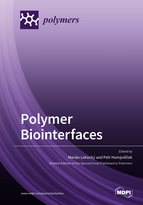Polymer Biointerfaces
A special issue of Polymers (ISSN 2073-4360). This special issue belongs to the section "Polymer Applications".
Deadline for manuscript submissions: closed (30 November 2019) | Viewed by 73540
Special Issue Editors
Interests: polymer surfaces; surface modification; polymer–cell interaction; polymer surface characterization; polymer biomaterials
Special Issues, Collections and Topics in MDPI journals
2. Centre of Polymer Systems, Tomas Bata University in Zlín, Zlín, Czech Republic
Interests: polymer biomaterials; cell biology and genetics; polymer biocompatibility; biomimetic materials
Special Issues, Collections and Topics in MDPI journals
Special Issue Information
Dear Colleagues,
Polymer biointerfaces are considered a suitable alternative to the improvement and development of numerous applications. The optimization of polymer surface properties can control several biological processes, such as cell adhesion, proliferation, viability, and enhanced extracellular matrix secretion functions at biointerfaces.
This Special Issue on Polymer Biointerfaces is focused on fundamental and applied research on polymers and systems with biological origin. Submissions should contain both polymer material background and descriptions of interacting biological phenomena or relevance to prospective applications in biomedical, biochemical, biophysical, biotechnological, food, pharmaceutical, or cosmetic fields.
Special attention will be given to polymer bio-surface modification, bio-coatings, cell–polymer surface interactions, self-assembling monolayers on polymers, in-vivo and in-vitro systems, protein–polymer surface interaction, polysaccharide–polymer interactions, biotribology, bio chip, biosensors, nano-bio interfaces, coatings, biofilms, adhesion phenomena, and molecular recognition, among others.
Assoc. Prof. Marián Lehocký
Assoc. Prof. Petr Humpolíček
Guest Editors
Manuscript Submission Information
Manuscripts should be submitted online at www.mdpi.com by registering and logging in to this website. Once you are registered, click here to go to the submission form. Manuscripts can be submitted until the deadline. All submissions that pass pre-check are peer-reviewed. Accepted papers will be published continuously in the journal (as soon as accepted) and will be listed together on the special issue website. Research articles, review articles as well as short communications are invited. For planned papers, a title and short abstract (about 100 words) can be sent to the Editorial Office for announcement on this website.
Submitted manuscripts should not have been published previously, nor be under consideration for publication elsewhere (except conference proceedings papers). All manuscripts are thoroughly refereed through a single-blind peer-review process. A guide for authors and other relevant information for submission of manuscripts is available on the Instructions for Authors page. Polymers is an international peer-reviewed open access semimonthly journal published by MDPI.
Please visit the Instructions for Authors page before submitting a manuscript. The Article Processing Charge (APC) for publication in this open access journal is 2700 CHF (Swiss Francs). Submitted papers should be well formatted and use good English. Authors may use MDPI's English editing service prior to publication or during author revisions.
Keywords
- polymer surface
- biointerface
- polymer–cell interaction
- polymer modification
- polymer biomaterials
- biofilms
- biotribology
- bio chip
- nano-bio interfaces
- polymer surface interaction








